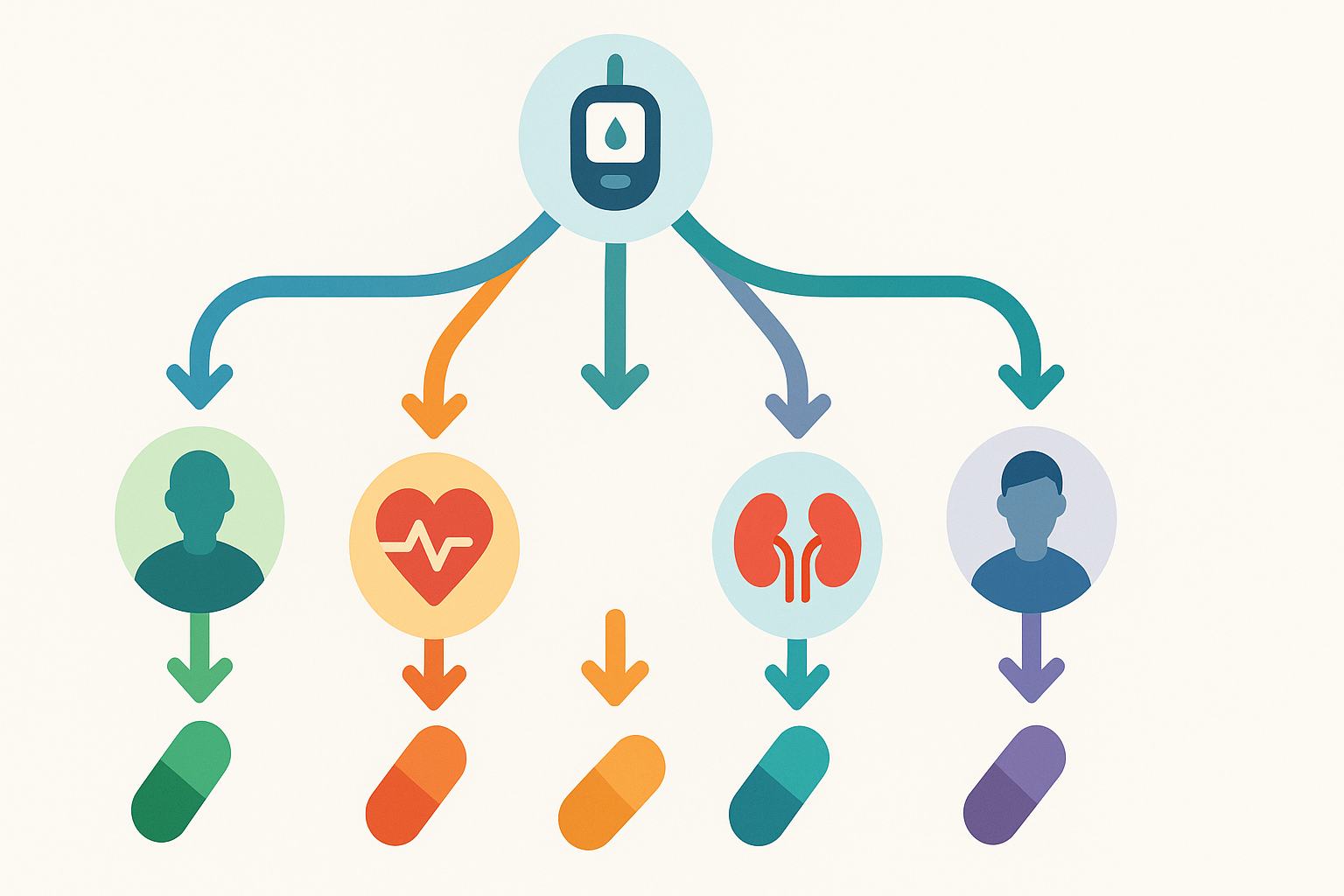Understanding the Evolving Landscape of Type 2 Diabetes Treatment
The landscape of type 2 diabetes treatment has undergone a transformative shift in recent years, driven by breakthroughs in clinical research and a deeper understanding of how individual patients respond to medications. No longer is diabetes management a one-size-fits-all endeavor. Instead, precision medicine is increasingly informing how we approach glycemic control, reduce complications, and improve long-term outcomes. Central to this shift is the diabetic medication chart, a dynamic tool that synthesizes evolving drug efficacy data, mechanisms of action, and patient-specific considerations. These charts, especially the most recent versions derived from clinical trials, offer new insights into how medications can be matched with patient profiles for better control of hemoglobin A1C levels and reduced risk of comorbidities.
You may also like: Breakthroughs in Current Diabetes Research: What the Latest Studies Reveal About Treatment and Prevention
As more is discovered about the genetic, metabolic, and behavioral variability among people with type 2 diabetes, the importance of personalization in therapy continues to grow. Traditional models of therapy initiation—starting with metformin and adding medications incrementally—are giving way to more individualized approaches that take cardiovascular risk, renal function, and even ethnicity into account. This evolution in clinical guidance is reflected in the structure and content of the latest diabetic medication chart. These charts no longer merely categorize drugs by class but now incorporate clinical outcomes data, patient-reported tolerability, and guidance from landmark trials. As a result, healthcare professionals are now better equipped to tailor treatment to the unique needs of each individual.

The Rise of the Diabetic Medication Chart as a Clinical Tool
Historically, charts outlining diabetes medications served a fairly simple purpose: to categorize oral and injectable agents based on their mechanism of action. However, with the explosion of research into pharmacologic interventions for type 2 diabetes over the past decade, the scope and utility of the diabetic medication chart have expanded dramatically. Today’s charts offer a rich, multidimensional view of medication options, organized not only by drug class but also by A1C-lowering efficacy, potential side effects, impact on body weight, risk of hypoglycemia, renal considerations, and cardiovascular outcomes.
One key reason for the growing relevance of these tools lies in the complexity of available medications. With new drug classes like SGLT2 inhibitors and GLP-1 receptor agonists entering the mainstream, clinicians need efficient ways to synthesize rapidly expanding data. The latest type 2 diabetes medications chart now includes these newer agents alongside traditional medications such as sulfonylureas, DPP-4 inhibitors, and insulin. Each entry often references pivotal trials like EMPA-REG, LEADER, and DECLARE-TIMI, offering evidence-based context for drug selection. In clinical settings, these charts have become indispensable—not only for physicians but also for pharmacists, diabetes educators, and patients seeking a better understanding of their treatment options.
Moreover, these charts have been instrumental in promoting shared decision-making. When clinicians can explain a medication’s benefits and risks using concise, visual tools, patients are more likely to engage in their care. In this way, the diabetic medication chart bridges the gap between complex data and practical decision-making, making it a powerful ally in the quest for personalized care.

How Clinical Trials Shape the Type 2 Diabetes Medications Chart
The type 2 diabetes medications chart is not a static document—it is constantly evolving in response to the results of ongoing clinical trials. As trials investigate the efficacy, safety, and long-term outcomes of various therapies, the findings directly inform the positioning of drugs within these charts. Some of the most influential trials of the past decade have upended traditional thinking about which drugs should be prioritized. For instance, studies like LEADER and SUSTAIN-6 have demonstrated that certain GLP-1 receptor agonists not only lower blood glucose effectively but also reduce major adverse cardiovascular events. These findings have pushed such medications to the forefront in the latest charts.
Similarly, the emergence of SGLT2 inhibitors as agents that provide renal and cardiovascular protection—even in patients without overt diabetes—has transformed how they are recommended. The EMPA-KIDNEY and DAPA-CKD trials revealed benefits far beyond glucose control, prompting a reevaluation of when and for whom these medications should be prescribed. As a result, the latest a1c lowering drugs chart includes not only glycemic metrics but also cardiovascular and renal outcomes, offering a more holistic perspective on therapeutic benefit.
It’s also important to note the growing number of head-to-head trials comparing different medication classes. These studies allow researchers to identify not just whether a drug works, but how it compares to other agents in real-world scenarios. As these data are synthesized into updated charts, healthcare providers are equipped with comparative insights that enable better therapeutic alignment with patient priorities—be it weight loss, convenience, cost, or comorbidity management.

Personalization and the Role of Patient Profiles in Medication Selection
The personalization of diabetes care is not simply about offering more choices; it’s about matching the right treatment to the right patient. As clinical trials reveal more about how individual characteristics influence drug response, the latest diabetic medication chart incorporates these variables more deliberately. For example, a patient with obesity and type 2 diabetes may benefit more from a GLP-1 receptor agonist due to its weight-lowering properties, whereas a patient with heart failure may find greater advantage in an SGLT2 inhibitor.
Age, renal function, history of cardiovascular disease, and socioeconomic status all play critical roles in therapeutic decision-making. The most advanced type 2 diabetes medications charts now reflect these variables through embedded notes and stratified recommendations. These insights are often drawn from subgroup analyses in trials, offering clinicians a finer degree of nuance. Such personalization helps avoid blanket prescriptions that may fail to consider critical patient factors and may improve medication adherence by aligning with patient goals and tolerances.
Additionally, these charts aid in visualizing the interplay between medication and patient profile. A1C-lowering potency is not the only parameter being weighed—treatment burden, side effect risk, and even potential for long-term organ protection are now part of the calculus. This broader view marks a significant evolution in how clinicians interpret the data and initiate discussions with their patients.

Integrating A1C Targets with Evidence-Based Drug Selection
Managing type 2 diabetes hinges on achieving and maintaining individualized A1C targets, and recent research underscores the importance of using evidence-based strategies to meet these goals. The updated a1c lowering drugs chart plays a crucial role in this process by synthesizing clinical trial data on how each class of drugs affects hemoglobin A1C. Rather than applying a uniform goal of below 7%, contemporary guidelines now advocate for personalized targets based on age, comorbidities, risk of hypoglycemia, and life expectancy.
Within this nuanced framework, the a1c lowering drugs chart offers practical guidance. For patients with newly diagnosed diabetes and minimal comorbidity, a more aggressive A1C target may be appropriate, supported by potent glucose-lowering agents like GLP-1 receptor agonists or combination oral therapies. Conversely, for older adults or those with complex health needs, moderate A1C targets may be pursued using agents with lower risk profiles. Clinical trial evidence, such as the UKPDS and ADVANCE studies, informs these stratifications, which are now reflected in the most current versions of the chart.
Another vital component is treatment de-escalation. For patients who reach glycemic targets or experience side effects, clinicians may consult the chart to identify medications that can be safely tapered or replaced. This dynamic usage underscores the importance of the chart as a living tool—one that reflects not only initial selection but also ongoing medication management.

The Impact of Cost and Accessibility on Medication Utilization
While clinical efficacy is essential, cost and accessibility often determine whether a patient can consistently adhere to their treatment regimen. The diabetic medication chart has evolved to include not just pharmacologic data but also considerations of cost-effectiveness and insurance coverage. With the rising cost of branded medications—especially newer agents like SGLT2 inhibitors and GLP-1 receptor agonists—healthcare providers must balance ideal therapy with financial feasibility.
Recent studies on healthcare utilization have emphasized how economic barriers can undermine even the most evidence-based recommendations. Charts now often include tiers or annotations indicating whether a drug is covered by major insurance plans or available in generic form. This transparency supports more realistic prescribing, helping patients avoid financial strain that could lead to nonadherence.
Moreover, accessibility is not limited to financial cost. Geographic disparities, pharmacy availability, and cultural acceptability also play roles in whether a medication is feasible for a given patient. The integration of these factors into the type 2 diabetes medications chart represents a maturing perspective—one that views the patient not just as a clinical case, but as a person navigating complex systems.
Real-World Evidence and Its Role in Updating Charts
Randomized controlled trials remain the gold standard for clinical evidence, but real-world data have become increasingly influential in shaping treatment guidelines and charts. Observational studies, patient registries, and post-marketing surveillance provide insights into how drugs perform outside of the tightly controlled environment of clinical trials. These findings are particularly useful for understanding long-term safety, adherence patterns, and population-specific efficacy.
The diabetic medication chart now reflects this expanded scope of evidence. For example, while a clinical trial might demonstrate a drug’s capacity to lower A1C by a specific percentage, real-world data might reveal that its tolerability or administration complexity reduces adherence. This practical dimension is invaluable for crafting sustainable treatment plans, and its inclusion within updated charts ensures more grounded decision-making.
Data from large healthcare systems and national diabetes registries have also illuminated disparities in care. For instance, certain ethnic groups may respond differently to specific medications, or face systemic barriers to accessing newer therapies. Incorporating these insights into the chart helps close care gaps and promotes more equitable treatment strategies.
Frequently Asked Questions: Personalized Diabetes Treatment and the Evolving Role of Medication Charts
1. How do diabetic medication charts help uncover treatment gaps in underserved populations?
While the primary function of a diabetic medication chart is to guide therapy selection, these charts are increasingly being used to identify inequities in diabetes care. In underserved populations, limited access to newer medications often results in over-reliance on older drugs that may not offer the same cardiovascular or renal benefits. A well-structured diabetic medication chart can highlight disparities in treatment recommendations versus actual utilization. For example, certain communities may lack access to GLP-1 receptor agonists despite evidence of their superior A1C reduction and organ protection. Integrating demographic utilization data into these charts can help clinicians advocate for more equitable treatment protocols.
2. Can medication charts be customized to reflect cultural dietary patterns and lifestyle habits?
Standardized charts, like the typical type 2 diabetes medications chart, often overlook cultural and lifestyle nuances that significantly influence treatment outcomes. However, there’s a growing movement toward culturally adapted medication frameworks. For instance, in regions where dietary carbohydrate load is traditionally high, medications that mitigate postprandial glucose spikes may be prioritized. Tailoring the diabetic medication chart to reflect such regional considerations helps improve patient adherence and outcomes. Incorporating lifestyle alignment into the chart format transforms it from a clinical tool into a culturally competent guide for real-world implementation.
3. How are digital platforms enhancing the functionality of the a1c lowering drugs chart?
With the integration of artificial intelligence and real-time data analytics, the traditional a1c lowering drugs chart is being transformed into an interactive, decision-support system. These digital platforms can dynamically update based on a patient’s electronic health record, providing real-time suggestions based on current A1C levels, comorbidities, and medication history. By pulling from national databases and clinical trial outcomes, these tools can simulate expected A1C trajectories based on selected therapies. This capability allows clinicians to visualize not just current treatment fit, but potential long-term outcomes. Ultimately, digitized charts empower personalized medicine by merging evidence with prediction.
4. What role do pharmacists play in interpreting type 2 diabetes medications charts for patients?
Pharmacists are uniquely positioned to bridge the gap between clinical data and patient comprehension. While physicians may focus on diagnosis and prescription, pharmacists can use the type 2 diabetes medications chart to explain side effect profiles, medication timing, and potential interactions in a way that resonates with patients. Their training enables them to interpret complex medication charts and translate them into accessible language, especially when patients are transitioning between therapies. Furthermore, pharmacists can help ensure that the chart recommendations align with insurance formularies, improving affordability and adherence. Their collaborative role enhances patient empowerment through education.
5. How do newer versions of the diabetic medication chart account for mental health conditions?
Recent versions of the diabetic medication chart are beginning to include considerations for coexisting mental health disorders, which have a strong bidirectional relationship with diabetes. Certain antidiabetic agents can exacerbate or alleviate symptoms of depression or anxiety, which in turn influence adherence and glycemic control. For example, weight gain from certain medications may negatively affect body image in patients with depression, worsening their overall condition. Updated charts now annotate medications that are neutral or beneficial to mood disorders, guiding clinicians toward more holistic care. This evolution underscores the importance of addressing psychological factors within diabetes management.
6. In what ways do charts help prevent overtreatment and polypharmacy in older adults?
Older adults with type 2 diabetes are particularly vulnerable to the risks of polypharmacy, including hypoglycemia, drug interactions, and cognitive decline. A well-designed diabetic medication chart can be instrumental in simplifying treatment regimens by identifying medications with overlapping effects or unnecessary combinations. It may also prioritize drugs with lower hypoglycemia risk and fewer dosing complexities, such as once-weekly injectables or combination pills. These charts increasingly incorporate geriatric-specific annotations, encouraging clinicians to regularly reassess therapy in light of life expectancy and frailty. In doing so, they help strike a balance between glycemic control and quality of life.
7. How are researchers using global data to refine the a1c lowering drugs chart?
The globalization of clinical research has expanded the scope of data used to inform the a1c lowering drugs chart. International registries and cross-border studies allow researchers to examine drug efficacy and safety across diverse populations, leading to more generalizable and nuanced recommendations. For instance, the effectiveness of certain therapies may differ between populations due to genetic variations in drug metabolism. Incorporating such findings into the chart helps tailor guidance for different ethnic groups and environmental exposures. This broader lens ensures that the chart remains inclusive, evidence-driven, and globally applicable.
8. What should patients look for when reviewing a type 2 diabetes medications chart with their provider?
Patients should pay close attention to more than just the A1C-lowering capabilities of medications. A comprehensive type 2 diabetes medications chart also includes factors such as weight impact, risk of hypoglycemia, mode of administration, and even cardiovascular outcomes. Patients should ask how each medication aligns with their personal health goals, lifestyle, and financial situation. Understanding the full context of each drug can help patients make informed decisions and feel more confident in their care plan. An engaged discussion using the chart as a visual aid often leads to better adherence and improved satisfaction with treatment.
9. How can healthcare systems use the diabetic medication chart to promote cost-effective prescribing?
Healthcare systems face increasing pressure to optimize resources while maintaining high-quality care. By integrating cost-effectiveness data into the diabetic medication chart, systems can guide clinicians toward therapies that deliver the best outcomes per dollar spent. This doesn’t mean choosing the cheapest drug, but rather the one that provides the most value given a patient’s specific needs. Including formulary status, rebate programs, and patient assistance options within the chart framework further enhances its practicality. Over time, this approach contributes to more sustainable healthcare delivery without compromising on individualized treatment quality.
10. What future innovations are expected in diabetic medication chart design?
The next frontier in diabetic medication chart design involves predictive modeling, machine learning, and patient-reported outcome integration. Future charts may include digital overlays that project long-term risk reduction based on therapy selection, or integrate continuous glucose monitoring (CGM) data for real-time adjustments. Additionally, incorporating patient satisfaction scores and lifestyle compatibility feedback will make the chart even more patient-centered. These innovations aim to make the chart not just a clinical summary, but a dynamic dashboard for shared decision-making. As treatment complexity grows, so too will the sophistication of these essential tools.
Conclusion: Why the Diabetic Medication Chart Is Essential for the Future of Personalized Type 2 Diabetes Care
As we move further into an era defined by precision medicine, the diabetic medication chart stands as one of the most powerful tools for delivering individualized, evidence-based care. Far from being a simple reference, it is now a dynamic synthesis of clinical trial findings, real-world outcomes, pharmacoeconomic data, and patient-centered variables. This evolution reflects a broader commitment in medicine to tailoring treatment in ways that honor both scientific rigor and human complexity.
The integration of newer drug classes, personalized A1C targets, cardiovascular and renal outcomes, and socioeconomic considerations has transformed the chart into a living framework for therapeutic decision-making. The incorporation of the a1c lowering drugs chart and the type 2 diabetes medications chart into routine practice ensures that clinicians remain current with the latest evidence while honoring each patient’s unique context. As such, these tools represent not just summaries of pharmacologic options, but blueprints for optimized, compassionate care.
Ultimately, the future of diabetes management lies not in the discovery of a single magic bullet but in the intelligent orchestration of multiple therapeutic strategies. The diabetic medication chart, enriched by ongoing clinical research and adapted for real-world use, exemplifies how we can turn data into action. In doing so, we offer patients not only longer lives but better ones—lives marked by control, confidence, and a care plan that truly fits.
Further Reading:
Exploring the recent advancements and future prospects of personalized medicine in type 2 diabetes
Type II diabetes mellitus: a review on recent drug based therapeutics
Promising new treatment strategy for type 2 diabetes
Disclaimer
The information contained in this article is provided for general informational purposes only and is not intended to serve as medical, legal, or professional advice. While MedNewsPedia strives to present accurate, up-to-date, and reliable content, no warranty or guarantee, expressed or implied, is made regarding the completeness, accuracy, or adequacy of the information provided. Readers are strongly advised to seek the guidance of a qualified healthcare provider or other relevant professionals before acting on any information contained in this article. MedNewsPedia, its authors, editors, and contributors expressly disclaim any liability for any damages, losses, or consequences arising directly or indirectly from the use, interpretation, or reliance on any information presented herein. The views and opinions expressed in this article are those of the author(s) and do not necessarily reflect the official policies or positions of MedNewsPedia.


